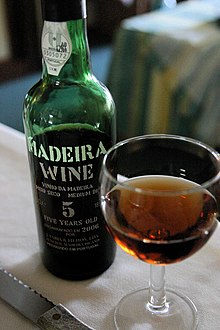
Back Vin de Madeira AN نبيت ماديرا ARZ Мадэра Byelorussian Мадейра (вино) Bulgarian Vi de Madeira Catalan Madeira (víno) Czech Мадера CV Madeira (vin) Danish Madeira (Wein) German Οίνος της Μαδέρας Greek

Madeira is a fortified wine made on the Portuguese Madeira Islands, off the coast of Africa. Madeira is produced in a variety of styles ranging from dry wines which can be consumed on their own, as an apéritif, to sweet wines usually consumed with dessert. Cheaper cooking versions are often flavoured with salt and pepper for use in cooking, but these are not fit for consumption as a beverage.
The islands of Madeira have a long winemaking history, dating back to the Age of Exploration (approximately from the end of the 15th century) when Madeira was a standard port of call for ships heading to the New World or East Indies. To prevent the wine from spoiling, neutral grape spirits were added. On the long sea voyages, the wines would be exposed to excessive heat and movement which transformed the flavour of the wine. This was discovered by the wine producers of Madeira when an unsold shipment of wine returned to the islands after a round trip.[citation needed]
Today, Madeira is noted for its unique winemaking process which involves oxidizing the wine through heat and ageing. The younger blends (three and five years old) are produced with the aid of artificial application of heat to accelerate the aging process; the older blends, colheitas and frasqueiras, are produced by the canteiro method. Because of the way these wines are aged, they are very long-lived in the bottle, and those produced by the canteiro method will survive for decades and even centuries, even after being opened. Wines that have been in barrels for many decades are often removed and stored in demijohns where they may remain unharmed indefinitely.
Some wines produced in small quantities in Crimea, California, and Texas are also referred to as "Madeira" or "Madera"; however, most countries conform to the EU PDO regulations and limit the use of the term Madeira or Madère to wines that come from the Madeira Islands.[1]
- ^ "Labeling of wine and certain other wine sector products". Europa: Summaries of EU legislation. 20 August 2007.